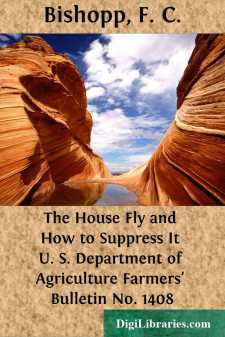Categories
- Antiques & Collectibles 13
- Architecture 36
- Art 48
- Bibles 22
- Biography & Autobiography 813
- Body, Mind & Spirit 142
- Business & Economics 28
- Children's Books 14
- Children's Fiction 11
- Computers 4
- Cooking 94
- Crafts & Hobbies 4
- Drama 346
- Education 46
- Family & Relationships 57
- Fiction 11828
- Games 19
- Gardening 17
- Health & Fitness 34
- History 1377
- House & Home 1
- Humor 147
- Juvenile Fiction 1873
- Juvenile Nonfiction 202
- Language Arts & Disciplines 88
- Law 16
- Literary Collections 686
- Literary Criticism 179
- Mathematics 13
- Medical 41
- Music 40
- Nature 179
- Non-Classifiable 1768
- Performing Arts 7
- Periodicals 1453
- Philosophy 64
- Photography 2
- Poetry 896
- Political Science 203
- Psychology 42
- Reference 154
- Religion 513
- Science 126
- Self-Help 84
- Social Science 81
- Sports & Recreation 34
- Study Aids 3
- Technology & Engineering 59
- Transportation 23
- Travel 463
- True Crime 29
The House Fly and How to Suppress It U. S. Department of Agriculture Farmers' Bulletin No. 1408
by: F. C. Bishopp
Categories:
Description:
Excerpt
KINDS OF FLIES FOUND IN HOUSES.
Several species of flies are found commonly in houses. Some of them so closely resemble the true house fly that it requires very careful observation to distinguish them from it.
One of these is the biting stable fly (fig. 1). It occurs frequently in houses and differs from the house fly in the important particular that its mouth parts are formed for piercing the skin. This fly is so often mistaken for the house fly that most people think that the house fly can bite.
Another frequent visitant of houses, particularly in the spring and fall, is the cluster fly. It is somewhat larger than the house fly, and is distinguished by its covering of fine yellowish hairs. Occasionally this fly occurs in houses in such numbers as to cause great annoyance. It gets its name of "cluster fly" from its habit of collecting in compact groups or clusters in protected corners during cold periods.
Several species of metallic greenish or bluish flies also are found occasionally in houses. These include a blue-bottle fly, the black blowflies, and the green-bottle (fig. 2) flies. They breed in decaying animal matter.
There is still another species, smaller than any of those so far mentioned, which is sometimes called the "lesser house fly." This insect is distinguished from the ordinary house fly by its paler and more pointed body. The male, which is commoner than the female, has large pale patches at the base of the abdomen, which are translucent when the fly is seen on the window pane. These little flies are not the young of the larger flies. Flies do not grow after the wings have once expanded and dried.
Fig. 1.— The stable fly. Much enlarged.
Fig. 2.— One of the green-bottle flies
(Lucilia caesar). Much enlarged.
In late summer and autumn many specimens of a small fruit fly, known as the "vinegar fly," make their appearance, attracted by the odor of overripe fruit.
All of these species, however, are greatly dwarfed in numbers by the common house fly. In 1900 the senior author made collections of the flies in dining rooms in different parts of the country, and found that the true house fly made up 98.8 per cent of the whole number captured. The remainder comprised various species, including those mentioned above.
Fig. 3.— The true house fly.
Enlarged.
The true house fly (fig. 3), which is found in nearly all parts of the world, is a medium-sized fly with four black stripes on the back and a sharp elbow in one of the veins of the wings. The house fly can not bite, its mouth parts being spread out at the tip for sucking up liquid substances.
The eggs (figs. 4, 5) are laid upon horse manure. This substance seems to be its favorite larval food. It will breed also in human excrement, and because of this habit it is very dangerous to the health of human beings, carrying as it does the germs of intestinal diseases, such as typhoid fever and cholera, from the excreta to food supplies. It has also been found to breed freely in hog manure, in considerable numbers in chicken dung, and to some extent in cow manure....


